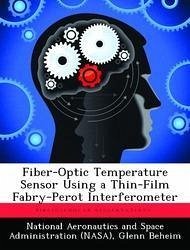A fiber-optic temperature sensor was developed that is rugged, compact, stable, and can be inexpensively fabricated. This thin-film interferometric temperature sensor was shown to be capable of providing a +/- 2 C accuracy over the range of -55 to 275 C, throughout a 5000 hr operating life. A temperature-sensitive thin-film Fabry-Perot interferometer can be deposited directly onto the end of a multimode optical fiber. This batch-fabricatable sensor can be manufactured at a much lower cost than can a presently available sensor, which requires the mechanical attachment of a Fabry-Perot interferometer to a fiber. The principal disadvantage of the thin-film sensor is its inherent instability, due to the low processing temperatures that must be used to prevent degradation of the optical fiber's buffer coating. The design of the stable thin-film temperature sensor considered the potential sources of both short and long term drifts. The temperature- sensitive Fabry-Perot interferometer was a silicon film with a thickness of approx. 2 microns. A laser-annealing process was developed which crystallized the silicon film without damaging the optical fiber. The silicon film was encapsulated with a thin layer of Si3N4 over coated with aluminum. Crystallization of the silicon and its encapsulation with a highly stable, impermeable thin-film structure were essential steps in producing a sensor with the required long-term stability.
Hinweis: Dieser Artikel kann nur an eine deutsche Lieferadresse ausgeliefert werden.
Hinweis: Dieser Artikel kann nur an eine deutsche Lieferadresse ausgeliefert werden.








